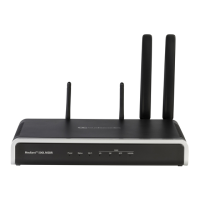User's Manual 1012 Document #: LTRT-10466
Mediant 500L MSBR
Parameter Description
message body (i.e., SDP).
[1] 1 = The device sends 'qop=auth-int' in the SIP response,
indicating required authentication and authentication with
integrity (e.g., checksum). This option restricts the client to
authenticating the entire SIP message, including the body, if
present.
[2] 2 = (Default) The device sends 'qop=auth, auth-int' in the
SIP response, indicating either authentication or integrity. This
enables the client to choose 'auth' or 'auth-int'. If the client
chooses 'auth-int', then the body is included in the
authentication. If the client chooses 'auth', then the body is not
authenticated.
[3] 3 = No 'qop' parameter is offered in the SIP 401 challenge
message.
Web: SBC User Registration
Time
CLI: sbc-usr-rgstr-time
[SBCUserRegistrationTime]
Global parameter that defines the duration (in seconds) of the
periodic registrations that occur between the user and the device
(the device responds with this value to the user). You can also
configure this functionality per specific calls, using IP Profiles
(IpProfile_SBCUserRegistrationTime). For a detailed description
of this parameter and for configuring this functionality in the IP
Profile table, see ''Configuring IP Profiles'' on page 332.
Note: If this functionality is configured for a specific IP Profile, the
settings of this global parameter is ignored for calls associated
with the IP Profile.
Web: SBC Proxy Registration
Time
CLI: sbc-prxy-rgstr-time
[SBCProxyRegistrationTime]
Defines the duration (in seconds) for which the user is registered
in the proxy database (after the device forwards the REGISTER
message). This value is sent in the Expires header. When set to
0, the device sends the Expires header's value as received from
the user to the proxy.
The valid range is 0 to 2,000,000 seconds. The default is 0.
CLI: config-voip>sbc general-
setting sbc-rand-expire
[SBCRandomizeExpires]
Defines a value (in seconds) that is used to calculate a new value
for the expiry time in the Expires header of SIP 200 OK
responses for user registration and subscription requests from
users.
The expiry time value appears in the Expires header in
REGISTER and SUBSCRIBE SIP messages. When the device
receives such a request from a user, it forwards it to the proxy or
registrar server. Upon a successful registration or subscription,
the server sends a SIP 200 OK response. If the expiry time was
unchanged by the server, the device applies this feature and
changes the expiry time in the SIP 200 OK response before
forwarding it to the user; otherwise, the device does not change
the expiry time.
This feature is useful in scenarios where multiple users may
refresh their registration or subscription simultaneously, thereby
causing the device to handle many such sessions at a given time.
This may result in an overload of the device (reaching maximum
session capacity), thereby preventing the establishment of new
calls or preventing the handling of some user registration or
subscription requests. When this feature is enabled, the device
assigns a random expiry time to each user registration or
subscription and thus, ensuring future user registration and
subscription requests are more distributed over time (i.e., do not
all occur simultaneously).

